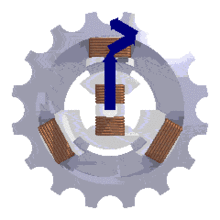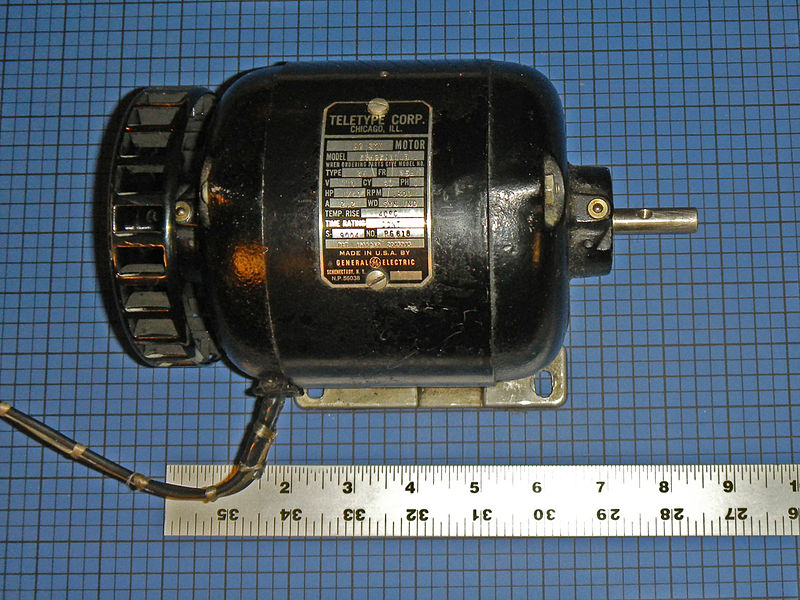Principle of Synchronous motor
Principle of Synchronous Motor
Introduction:
The Synchronous motor is electrical identical with an alternator. Thus a Synchronous machine may be used as an alternator When mechanically through a prime mover and it also may be used like a motor when its stator is supplied by three phase AC and rotor by dc excitation some characteristic features of a Synchronous motor as follows:
(1) It runs either on Synchronous speed or not at all. Then only a way to change its speed is to vary the supply frequency.
Because Ns=120f/p
(2) It is not self-starting. It has to be run up to Synchronous speed by some means (like another motor) and then it can be synchronized to supply.
It is identical motor which rotor rotates only on Synchronous speed.
Principle of Synchronous Motor
We Know that when a three phase winding is supplied by a three phase supply, then it produced a
magnetic field, rotating at synchronous speed (Ns=120f/p).The Poles are rotating at Synchronous speed in clockwise direction. The rotor has also the same number of poles (N & S) and the speed of stator magnetic field is synchronous speed
Thus it is clear that the stator of synchronous motor is supplied by a three phase AC supply and the rotor by DC supply. The stator generates rotating magnetic field and rotor generates a stationary magnetic field
Main Working
 The stator and rotor poles are attracting each other. Suppose that the rotor is rotating clock wise with the same speed, stator poles .Thus when the stator poles change their position, in the same time the rotor poles also interchange their position and here the stator and rotor poles attract each other. Thus there will be a magnetic locking between stator and rotor poles and the will experience a unidirectional torque and move on the same speed. The speed of magnetic field is synchronous speed thus it is clear that the stator of synchronous motor is supplied by a three phase A.C supply and the rotor by D.C supply. The stator generates rotating magnetic field and rotor generates stationary poles. If the rotor is rotated by some external means (like an other motor) on the synchronous speed (speed of stator flux) now the prime mover may be separated from the rotor .If rotor, s speed is less than the synchronous speed. Then the magnetic locking between stator and rotor poles get broken and rotor will get stopped. Thus the synchronous motor or not at all.
The stator and rotor poles are attracting each other. Suppose that the rotor is rotating clock wise with the same speed, stator poles .Thus when the stator poles change their position, in the same time the rotor poles also interchange their position and here the stator and rotor poles attract each other. Thus there will be a magnetic locking between stator and rotor poles and the will experience a unidirectional torque and move on the same speed. The speed of magnetic field is synchronous speed thus it is clear that the stator of synchronous motor is supplied by a three phase A.C supply and the rotor by D.C supply. The stator generates rotating magnetic field and rotor generates stationary poles. If the rotor is rotated by some external means (like an other motor) on the synchronous speed (speed of stator flux) now the prime mover may be separated from the rotor .If rotor, s speed is less than the synchronous speed. Then the magnetic locking between stator and rotor poles get broken and rotor will get stopped. Thus the synchronous motor or not at all.Synchronous motor Applications
There are following applications of synchronous motor
(A) Power factor Improvement
Over excited synchronous motor having leading power fetor are widely used for improving power factor of those systems which employ a large number of synchronous motor ,and other devices having lagging power factor
(B) Constant Speed Application
Because of their high efficiency and high speed, synchronous motors are well suited for loads where constant speed is required such as centrifugal pumps, belt driven reciprocating compressors, blowers, line shaft and paper mills etc.
(C) Voltage Regulation
The voltage at the end of a long transmission line varies greatly especially when large inductive load are present. When an inductive load s is present when an inductive load is suddenly disconnected, voltage tends to rise above its normal value because of the line capacitance by installing a synchronous motor with a field regulator. This voltage rise can be controlled.
(D) High load capacity
Its load capacity is higher than other type of motor
(E) Independent on applied voltage
The change in supply voltage does not affect synchronous motors.
